Ever felt like you're missing out on the best techniques for saltwater fishing with line? Imagine mastering the art of jigging, understanding the perfect hand line setup, and optimizing your gear for different types of saltwater fishing.
These techniques can be game-changers for your next fishing adventure, helping you reel in those prized catches. But that's just the beginning.
Stay tuned to uncover more tips that could elevate your saltwater fishing game to the next level.
Key Takeaways
- Choose the right fishing line type and weight for saltwater conditions.
- Master essential knot tying techniques for strong and reliable setups.
- Practice accurate casting methods and swift hook setting for success.
- Prioritize proper fish handling and release practices to protect marine life.
Hand Lining Basics
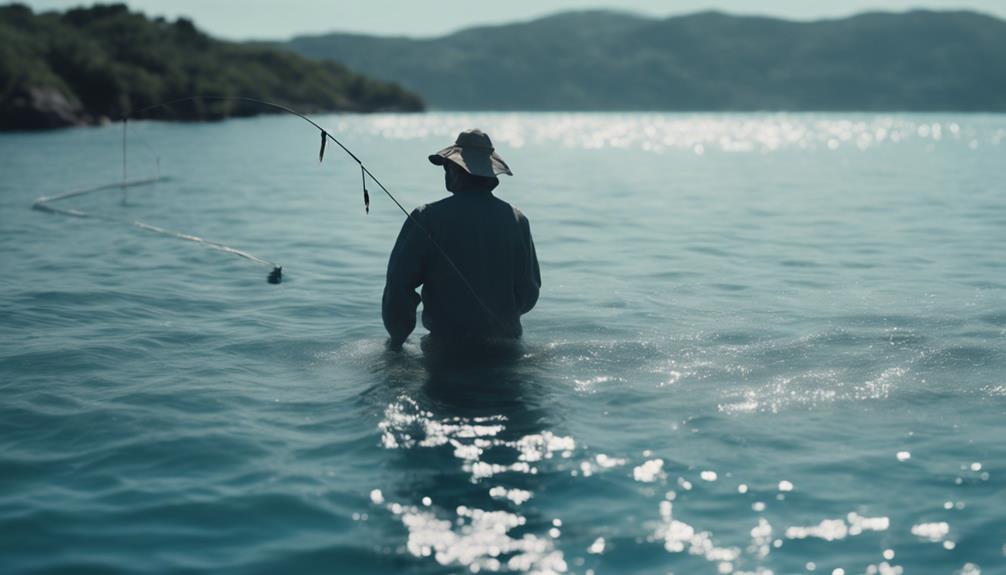
If you're looking to simplify your fishing experience and connect more directly with the fish, mastering hand lining basics is the way to go. Hand lining is a traditional method of fishing that's particularly effective in saltwater for catching small to medium-sized fish in shallow waters.
It requires skill and finesse to control the line without the aid of a rod or reel. The hands-on approach of hand lining allows anglers to feel the bites instantly through the line, creating a more connected experience with the fish.
This technique offers a more intimate and traditional way of fishing, where your skill and precision play an essential role in successfully landing your catch.
Targeting Saltwater Species
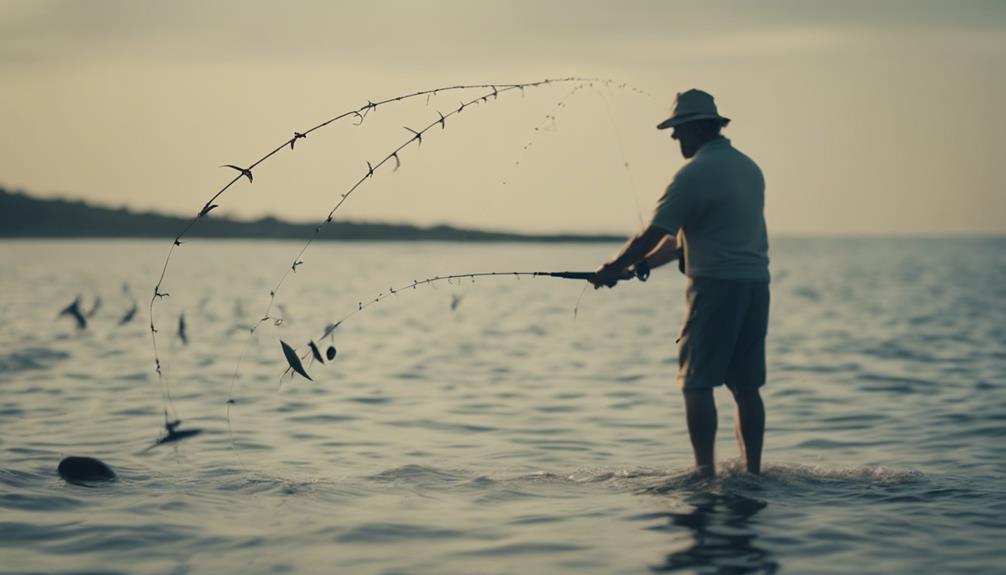
Ready to up your game in saltwater fishing? Targeting specific saltwater species requires understanding their behaviors and habitats for successful line fishing.
Different species like redfish, snook, and tarpon have unique behaviors and habitats, influencing your line fishing techniques. Some species, such as striped bass and bluefish, may benefit from using braided lines for their strength and sensitivity.
Adjusting the line weight and leader length based on the target species can improve your casting distance and bait presentation. When targeting species like king salmon and halibut, using fluorocarbon leaders enhances stealth and abrasion resistance.
Proper Hand Line Setup
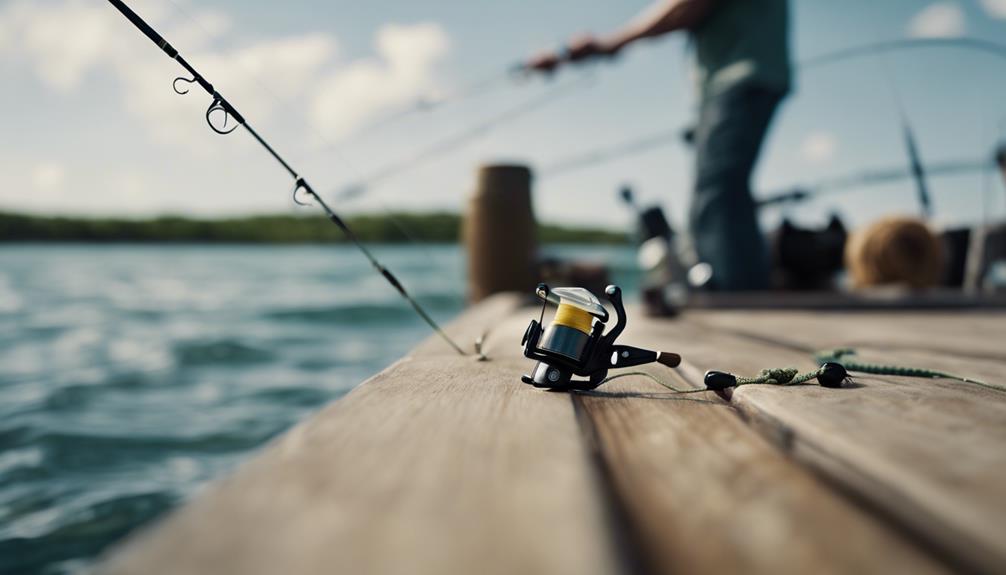
For a proper hand line setup in saltwater fishing, select a durable and strong braided or monofilament line.
Connect a swivel to prevent twisting and tangling while casting and retrieving. Use a heavy-duty snap swivel for easy attachment of various lures or bait.
Tie an improved clinch knot securely to link the swivel to the hand line.
Guarantee smooth casting and reeling by practicing good hand line management.
Mastering the Art of Jigging

To excel in saltwater fishing with jigging, focus on mastering the technique of moving your lure or bait up and down in the water column to attract a variety of fish species. When it comes to mastering the art of jigging, consider the following key points:
- Use Different Types of Jigs: Experiment with bucktail jigs, metal jigs, and soft plastic jigs to see what works best for the saltwater fish species you're targeting.
- Imitate Natural Prey Movement: Mimic the movement of prey by varying the speed and rhythm of your jigging to make it more enticing to the fish.
- Versatile Locations: Jigging can be done from boats, piers, or even while wading in shallow waters, offering a versatile approach to saltwater fishing success.
- Adapt and Learn: Keep refining your jigging techniques based on the behavior of the fish and the conditions of the water for improved results.
Drift Fishing Techniques
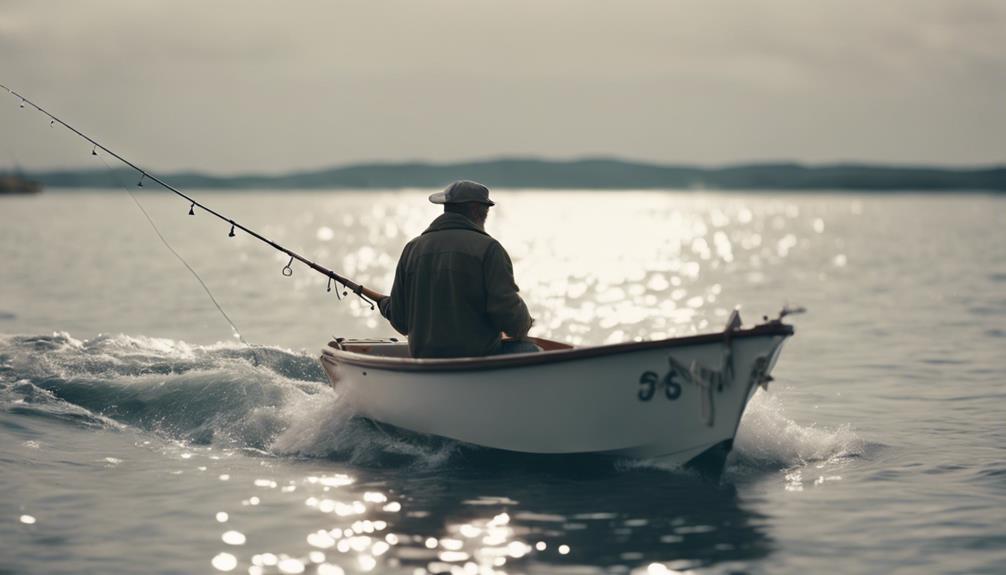
When drift fishing in saltwater, allow your bait or lure to naturally drift with the current to cover a wide area and target various fish species effectively.
To control the speed and depth of your drift, adjust the weight of your rig accordingly.
Drift fishing is ideal for open water or areas with moving currents, where different techniques like bottom bouncing or using suspending baits can be effective.
By understanding the movement of the current and adjusting your rig, you can increase your chances of hooking a variety of fish species.
Remember to pay attention to the behavior of your bait or lure as it drifts, as this can help you adapt your technique for better results in saltwater fishing.
Trolling for Saltwater Fish

Start by dragging bait or lures behind your moving boat to attract saltwater fish when trolling. Here are some key points to contemplate for successful trolling:
- Adjust Boat Speed: Find the right speed that entices the fish you're targeting.
- Control Depth: Experiment with different depths to see where the fish are biting.
- Choose the Right Bait: Use diving plugs, spoons, or artificial bait to appeal to a variety of species.
- Optimize Your Setup: Fine-tune your trolling speed, lure depth, and distance from the boat to maximize your chances of hooking a fish.
Bottom Fishing Strategies

When targeting bottom-dwelling fish species in saltwater, your focus shifts to employing effective bottom fishing strategies. Bottom fishing involves going after fish like snapper, grouper, flounder, and sea bass that hang out near the ocean floor.
To lure these fish, you'll need to understand their feeding patterns and behavior. Whether you're in shallow waters or deep seas, using the right rigs with weights to keep your bait down where the fish are is key. Different fish species have different preferences, so tailor your approach to your target species.
Using Live Bait Effectively
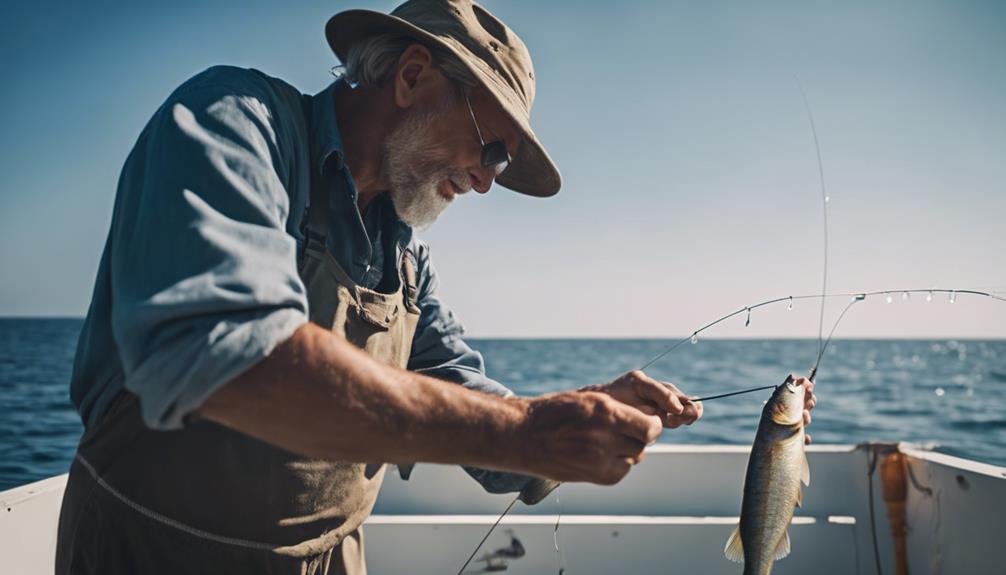
To use live bait effectively in saltwater fishing, selecting the right type of natural organisms commonly found in the ocean is essential. Here are some key tips for using live bait successfully:
- Choose Wisely: Opt for live bait like shrimp, mullet, or squid to attract a variety of saltwater fish species.
- Mimic Nature: Rig the live bait properly to imitate its natural movement, making it more appealing to predatory fish.
- Keep It Lively: Assure your live bait stays active on the hook to attract more fish and improve your chances of a successful catch.
- Know Your Targets: Understand the preferences of the target fish species to select the most suitable live bait for your saltwater fishing adventure.
Lure Fishing Tactics
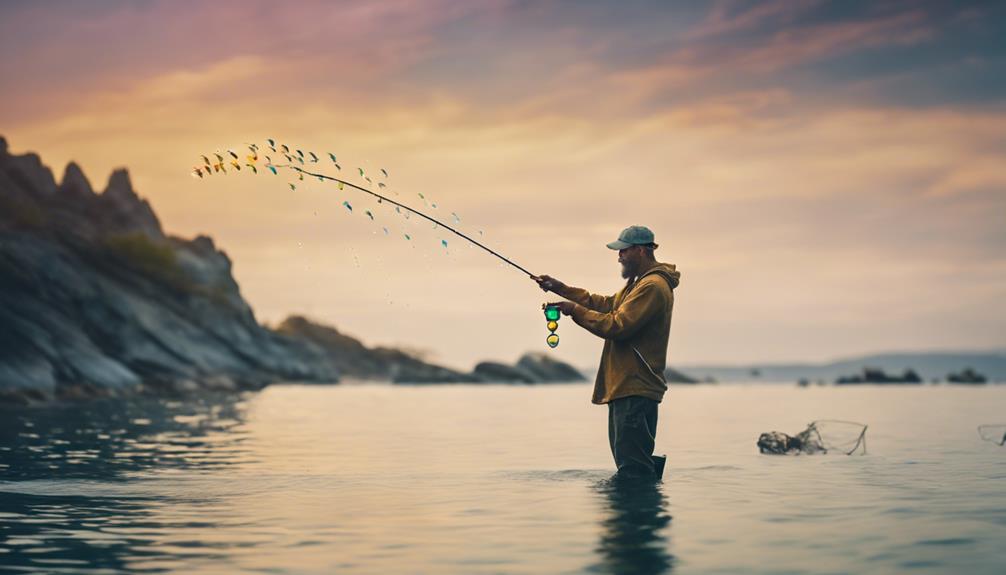
When moving from using live bait to lure fishing in saltwater, understanding effective tactics becomes key to attracting and catching your desired fish species.
Choose the right lure based on the target species and water conditions to increase your chances of success. Vary your retrieval speed and depth to mimic natural movement and entice strikes from saltwater fish.
Experiment with different types of lures like spoons, plugs, and soft plastics to find what works best in different situations. Use bright or reflective lures in clear water and darker or more natural-colored lures in murky conditions for better visibility.
Pay attention to the size, shape, color, and action of the lure to match the local baitfish and effectively attract predatory fish.
Landing and Handling Fish
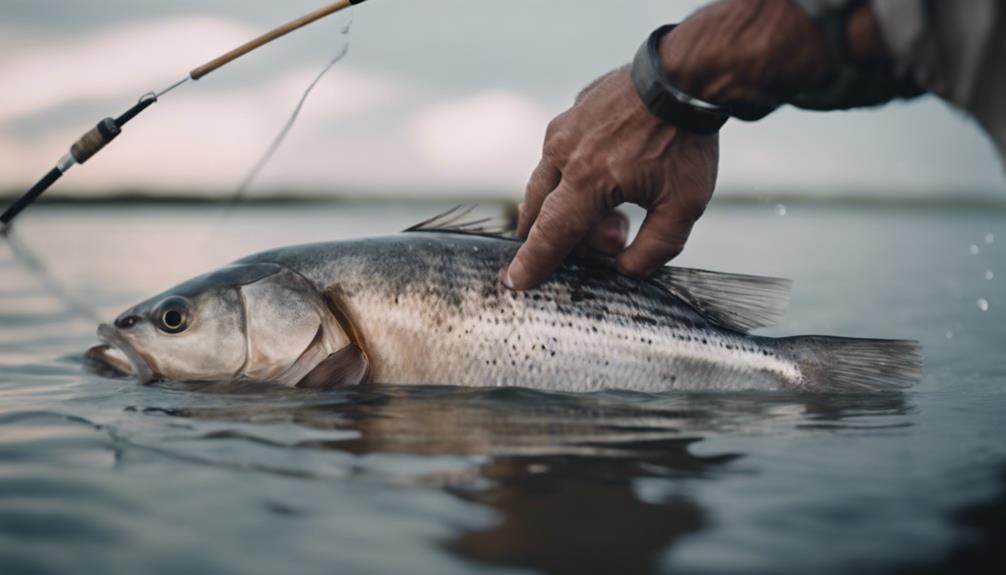
When landing a fish, remember to use a landing net for larger catches to avoid harm.
Wet your hands before handling the fish to keep them safe and prevent injury.
Also, be cautious with lip grips to not hurt the fish's jaw and feeding ability.
Proper Fish Handling
Safely land and handle fish by using a net or gaff and keeping your hands wet to protect their slime layer and scales.
Here are a few tips to guarantee proper fish handling:
- Use a net or gaff: Safely land the fish without causing harm or stress.
- Keep your hands wet: Protect the fish's slime layer and avoid removing scales.
- Avoid squeezing: Handle the fish gently, without putting excessive pressure on its body.
- Support the belly: When handling the fish, provide support under its belly to avoid bending its body unnaturally.
Safe Hook Removal
To safely remove a hook from a fish's mouth, use a pair of long-nose fishing pliers. This tool helps you carefully extract the hook without causing harm.
Remember to keep the fish's protective slime layer intact by avoiding handling them with dry hands. When holding the fish, do so gently and securely to minimize stress and injuries.
For deep-hooked fish, employ a dehooking tool to safely and swiftly remove the hook.
Throughout the process, aim to keep the fish in the water as much as possible to guarantee their well-being and a successful release.
Conclusion
So there you have it, the 10 best techniques for saltwater fishing with line.
Remember to practice your hand lining skills, target the right species, set up your gear properly, and master techniques like jigging and drift fishing.
Don't forget to use the right bait and lures, and always be prepared to handle and release your catch responsibly.
With these tips in mind, you'll be well on your way to a successful saltwater fishing adventure!
👨👩👧👦 Dwight’s a married dad of 4 who loves to cast a line 🎣 into both fresh and salt waters. His heart belongs to his family and the sea. 🌊 #FamilyMan #FishingLife #DadOf4 🐟✨

